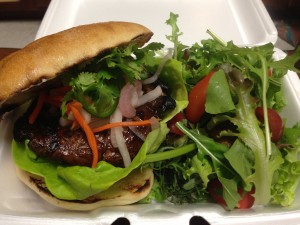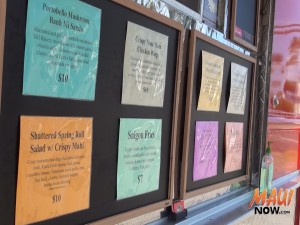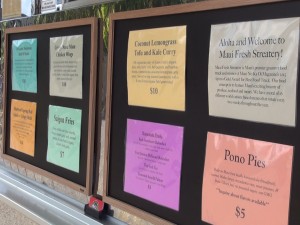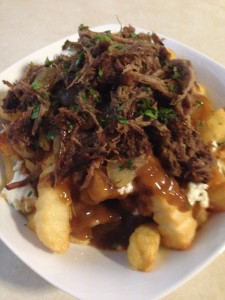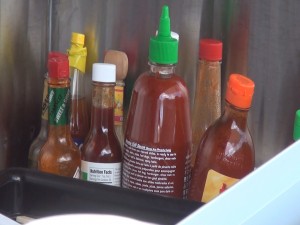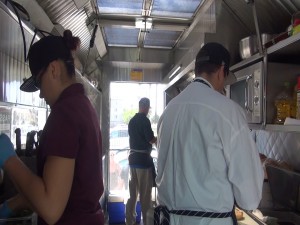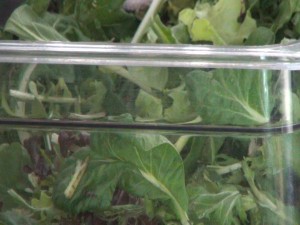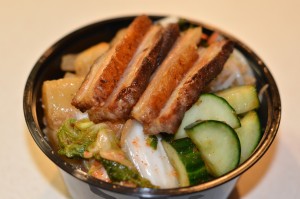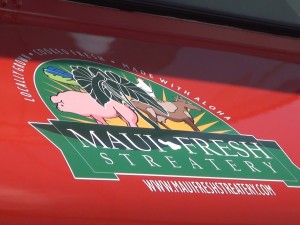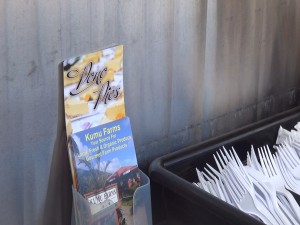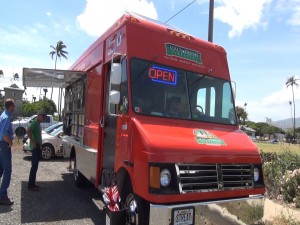Gourmet Grab & Go at Maui Fresh Streatery
[flashvideo file=http://www.youtube.com/watch?v=palnqhKR-yw /]
Cooking seems to come naturally to chef Kyle Kawakami. But the fact is, his initial career wasn’t anywhere near a kitchen. Although it did involve fish. Just not for searing, grilling or poaching. This fish was for studying.
“I have a degree in Marine Biology from University of Hawai’i at Manoa,” Kawakami explains. “But when you go to college and you think that something is cool, and you like diving and you like fishing and you like the ocean, that doesn’t necessarily translate into a career after you get your degree. So cooking wasn’t necessarily the first career choice for me per se, but it was always something that I’ve done. In high school, I cooked. In college, I cooked. And so it’s always been an interest.”
After graduating and dabbling in a few different managerial and hospitality-related jobs, Kawakami had an opportunity to take his interest in cooking a step further: in 2002, he enrolled in the culinary school at Maui Community College, now known as University of Hawaii Maui College (UHMC).
After graduating again, this time with a culinary degree, Kawakami spent about three years cooking at the Fairmont Kea Lani. Then came a call from the college, offering him a chance to teach in the culinary program.
“It started off as just a part-time gig while I was cooking; they asked me to fill-in on some cooking classes,” he says. “It ended up turning into a full-time deal where they gave me a full load of classes, and I taught pretty much all the classes within the program there. There’s probably two or three classes I did not teach within the whole two-year program. I stayed there for almost 10 years teaching.”
During that time, Kawakami educated scores of up-and-coming chefs, many of whom now have notable careers of their own. In fact, he says, “Almost every restaurant on the island has a chef I’ve taught in one way, shape or form!”
He taught, but he also learned. While Kawakami travelled for class work, continuing education and training on the mainland, he was drawn to a growing trend: food trucks and mobile food carts on the streets of cities like San Francisco, Seattle and Los Angeles.
“It seemed like the street food scene at the time was booming on the West Coast,” explains Kawakami. “My students would ask, ‘What’s the next big food trend, where is food going for Hawai’i?’ and food trucks were always something I brought up in my lectures, in that nobody was really doing it yet. And so when I left the school, it was kind of something that was in the back of my head already. I guess I had planted my own seed in my mind that it was something Maui needed.”
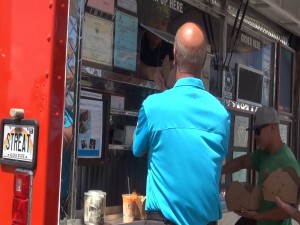
Chef Kyle Kawakami hands out lunch orders to customers at Maui Fresh Streatery. Photo by Kiaora Bohlool.
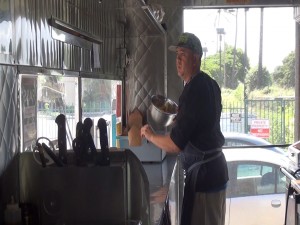
Chef Kyle Kawakami works in his gourmet food truck at Maui Fresh Streatery. Photo by Kiaora Bohlool.
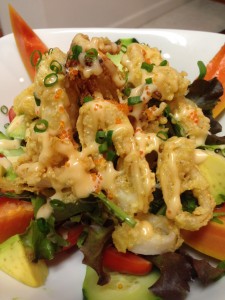
Crispy Calamari and Kumu Farms Organic non-GMO Papaya Salad at Maui Fresh Streatery. Photo by Kiaora Bohlool.
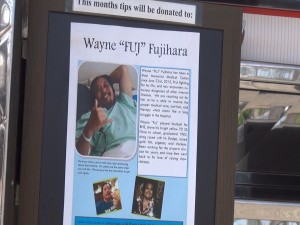
All tips are donated to different causes and non-profit groups at Maui Fresh Streatery. Photo by Kiaora Bohlool.
Kawakami pursued his passion, and in 2013 opened Maui Fresh Streatery, a big, red, gourmet food truck you’ll often see parked next to the Ilima Shell gas station at 137 East Ka’ahumanu Avenue in Kahului. Well, “often” may be a strong word. The truck serves lunch between 11 a.m. and 1 p.m. on Mondays, Wednesday and Fridays.
“I do that because it’s a small business, so a lot the work I do, I do myself to keep labor costs down,” explains Kawakami, who’s extremely involved with all his ingredients and stays connected to the sources of the food he serves. “Because we’re so busy, we tend to sell out a lot. And I need those days in between to go to the farms or to contact my fishermen or to go shopping. I’m not a full-size restaurant and selling out on a day-to-day basis requires you to reload, and get reloaded for the following days.”
Kawakami’s food is immensely popular, with gourmet lunch plates never that cost more than $10. He always plans to have enough food to last the full two-hour stretch, but on some busy days, he sells out within an hour. However, with a little culinary creativity, he usually manages to keep his customers happy.
“If we’re out of something, we can kinda create dishes on the fly,” he says. “I tell my employees that do work with me never to turn people away; if they’ve made an effort to come down to find us and eat our food, we try to always to get them something if at all possible.”
While he does the majority of the work himself, Kawakami hires a few of his former culinary students to assist on days of operation, maybe crafting salads or handling payments. But he enlisted something else from his culinary teaching days that’s become a cornerstone of his business: the menu rotates every two weeks, featuring one of 18 different types of global cuisine. Greek, Cajun, Korean, Indian, local, California, Italian, Japanese and French, to name a few. Kawakami announces each new menu using his primary source of marketing: social media. Right now, it’s Southeast Asian cuisine, with choices like portobello mushroom Banh Mi sandwich, Saigon fries, vegetarian green Thai curry and shattered spring roll salad with crispy Mahi. Once a menu theme is done, you won’t see it posted again for another six to eight months.
“One of the ways that I would teach my classes within the culinary program, and to keep it exciting, was we had these rotating menus,” Kawakami says. “So we would have these menus that would run for maybe two to three weeks at a time and then we’d switch them up and do something different.”
So a rotating menu can keep the culinary skills fresh. But when the food is also fresh, and as local as possible, from the fish to the greens to the honey, Kawakami says switching up the offerings just makes sense.
“By doing a locally-based ingredient list, you had to be pretty dynamic with the menu; you couldn’t have a fixed menu.” he explains, using Ahi as an example. “If you want to have Ahi on your menu all the time, and you want to support local, meaning local fishermen on island, they’re not always biting. So you’re gonna have to go to the block, or to importers to bring in your fish. And so by having a menu that’s always evolving and changing, if Ahi aren’t biting, I can switch to MahiMahi, if Mahi aren’t biting I can switch to Ono or Opakapaka and same holds true for the produce.”
Kawakami uses Kumu Farms for much of his organic produce, and says the ever-changing menu allows for flexibility and out-of-the-box thinking on exactly how to make use of what local farmers have to offer.
“That helps not only us in terms of prices, because we can look at things that are bumper-cropping and available,” says Kawakami, “but it helps them as well. They have a lot of a certain product and they’re trying to move it; people that have fixed menus may not be using it, so they’re kind of turning that away, but for us, if we can incorporate it into the menu, we can take product off their hands and help them move things.”
Along with the three-day-a-week lunch date on Ka’ahumanu Avenue, the small business owner shares his chef skills at a limited number of catering functions, charitable fundraisers and community events. In fact, you’ll see his red truck at the Made in Maui Festival this November at the MACC. He says last year, the event attracted around 9,000 people in a single day.
But there are key places you won’t see his red truck, or anyone else’s mobile food operation for that matter. Kawakami says finding allowable locations to do business is one of his industry’s biggest hurdles.
“People say ‘Hey, why don’t you just go to Kamaole 1 and open up shop, or why don’t you pull off to the side of the road at Laniupoko or Olowalu when the surf’s breaking, and you just can’t do that, because state and county restrictions prevent us from just pulling over and vending,” he explains. “I think because the whole street food scene here on Maui is still sort of new, the infrastructure of county government is not really set up for it yet. I’ve been fortunate to have good partners in my location, but I know it’s a challenge for a lot of other food truck vendors in finding locations to vend, because the county guidelines have been in place for a long time and haven’t really kept up with modern or more up-to-date services.”
Kawakami was born and raised on Maui, and says he’s committed to being an active part of his community. For instance, all of the money in his tip jar gets donated to a different local non-profit or cause each month, including Women Helping Women, Toys for Tots and individual medical fundraisers. He’s also donated to several school garden clubs because, “I think that’s important; having the students know where their foods come from.”
Although he may not officially be a culinary teacher anymore, Kawakami is educating in different ways now, visiting high schools to promote culinary arts, sharing his knowledge of global cuisine and showing diners that fresh, local, gourmet food can exist through a take-out window. He also says Maui Fresh Streatery has taught him what it means to really connect with customers.
“There’s days when I think a restaurant would be a lot easier, just because you have the size and you have the stability. But at the same time, I love the closeness of the food truck to your customers, where the customers come right up to the window; we are literally three feet away from the customers ordering their food, I speak with every customer as I hand out the food to them, so I get to thank each one of them,” he explains. “I think, a lot of times in restaurants, the chefs and cooks will be kind of hidden in the kitchen, and you leave that connectivity up to your hosts and your waiters and waitresses. And I really like that ability to interact with my customers and get to know them on a first-name basis. We have a ton of regulars that follow us and come to us weekly if not multiple times during the week, and it’s pretty cool; I haven’t had that connection in any form other than the food truck.”






